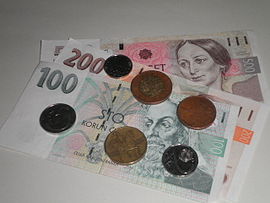Czech crown
| Czech crown ( Koruna česká ) |
|
|---|---|
| Country: |
|
| Subdivision: | 100 Haléřů (Heller) |
| ISO 4217 code : | CZK |
| Abbreviation: | Kč |
|
Exchange rate : (August 24, 2020) |
1 EUR = 26.091 CZK 1 CHF = 24.246 CZK |
The Czech crown ( Koruna česká ) has been the currency of the Czech Republic since February 8, 1993 (shortly after the division of Czechoslovakia and the establishment of the Czech Republic on January 1, 1993) . One crown is divided into 100 hellers (haléř) .
Coins and banknotes
There are or were the following coins : 1 crown, 2 crowns, 5 crowns, 10 crowns, 20 crowns and 50 crowns. The coins of 10, 20 and 50 Heller were withdrawn . In retail, however, calculations are still made in 10-Heller increments, but commercially rounded down or up to full crowns for cash payments.
The 50 kroner coin was minted in 1993 in order to accelerate the currency separation of the Czech Republic from Slovakia - it was not possible to print 50 kroner notes in a short period of time. After enough 50 kroner bills had been printed, the coins were withdrawn but remained valid. They were later put back into circulation because rising wages and prices meant that it was no longer worthwhile to print new banknotes (their purchasing power has decreased, currently around 2 euros, they are used a lot and therefore wear out too quickly).
The 50-krone coin was voted the coin of the year 1993 (most beautiful coin in the world) in the World Coins survey in the course coin category in 1994.
There are or were the following banknotes : 20 kroner (valid until August 31, 2008), 50 kroner (valid until March 31, 2011), 100 kroner, 200 kroner, 500 kroner, 1000 kroner, 2000 kroner and 5000 kroner. Furthermore, between February 8, 1993 and August 31, 1993 banknotes of 100 kroner, 500 kroner and 1000 kroner were printed in the design of the Czechoslovak krona, all of which were withdrawn on August 31, 1993.
For more information on the history of the crown, see the Czechoslovak crown .
Coins
| Face value | front | back | Motif front | Motif back | Weight | diameter | thickness | material | edge | First edition |
|---|---|---|---|---|---|---|---|---|---|---|
| 1 crown |
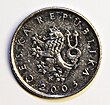
|

|
Bohemian lion | Wenceslas Crown | 3.6 g | 20 mm | 1.85 mm | Nickel plated steel | corrugated | 1993 |
| 2 crowns |
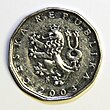
|
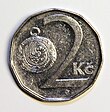
|
Bohemian lion | Great Moravian button jewelry | 3.7 g | 21.5 mm, elephant |
1.85 mm | Nickel plated steel | rounded, smooth | 1993 |
| 5 crowns |

|

|
Bohemian lion | Charles Bridge | 4.8 g | 23 mm | 1.85 mm | Nickel plated steel | smooth | 1993 |
| 10 crowns |

|

|
Bohemian lion | Petrov Hill with St. Peter and Paul Cathedral | 7.62 g | 24.5 mm | 2.55 mm | Copper plated steel | corrugated | 1993 |
| 20 crowns |
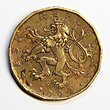
|

|
Bohemian lion | Wenceslas statue with the text of the Wenceslas choir: "SVATÝ VÁCLAVE NEDEJ ZAHYNOUT NÁM I BUDOUCÍM" ( St. Wenceslas, let us and the future not perish ) | 8.43 g | 26 mm triangle |
2.55 mm | Brass plated steel | rounded, smooth | 1993 |
| 50 crowns |

|
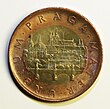
|
Bohemian lion | Prague old town , "PRAGA MATER URBIUM" ( Prague, mother of cities ) | 9.7 g | 27.5 mm | 2.55 mm | Ring: copper plated steel , core: brass plated steel | smooth | 1993 |
Commemorative coins were minted from silver at 200 and 500 kroner and from gold at 1000, 2000, 2500, 5000 and 10,000 kroner.
Banknotes
The plan to introduce a new series of post-communist banknotes was being pursued even before the secession of Slovakia. A design by the Czech Oldřich Kulhánek , who prevailed over his Slovak competitor Joseph Bubák , was to be used for the banknotes . The following portraits were planned:
10 crowns Prince Pribina
20 crowns Kyrill und Method
50 crowns Přemysl Otakar I.
100 crowns Charles IV.
200 crowns Johann Amos Comenius
500 crowns Ľudovít Štúr
1000 crowns František Palacký
2000 crowns Milan Rastislav Štefánik
5000 crowns Tomáš Garrigue Masaryk
After it became clear that the two countries would go their separate ways, the Slovak portraits had to be exchanged. Přemysl Otakar I. switched to the 20-kroner note and the female figures Agnes von Böhmen (50 kroner), Božena Němcová (500 kroner) and Emmy Destinn (2000 kroner) were added. The banknote designs for 100, 200 and 1000 kroner were largely completed by this time, only the bank name ( Státní banka československá ) and the denomination ("Czechoslovak crown") had to be changed.
The first issue of Czech National Bank banknotes was put into circulation in 1993. The 50, 100 and 500 kroner notes were produced in the UK printer De La Rue , while the 200, 1000 and 5000 kroner notes were produced in the Czech securities printing house . On the banknotes, this difference is expressed in the font used for the serial numbers printed on the lower edge. In addition, the notes produced in England show a visible color variance compared to the equivalents of the later issue years.
In 1994, the banknote series was expanded to include the 20-krone note. Together with the second edition of the 50-kroner note from 1994, the 100- and 500-kroner note from 1995 and the first edition of the 2000-kroner note from 1996, which completed the series, the design of the notes underwent a major innovation : Since then there has been a graphic symbol in the lower half of the watermark area on the back corresponding to the theme of the banknote. The symbol of the 100, 200, 500 and 2000 is green, that of the 20, 50, 1000 and 5000 is blue. A "flaw" in the concept of the series that had not been resolved until the issue of the 1000 kroner note from 1996 is the transparent register, which is the abbreviation Cs for Č esko s lovensko (Czechoslovakia).
Since the second issue of the 1000- krone note from 1996, the corrected transparent register has shown the abbreviation ČR for Č eská R epublika (Czech Republic). This change was then carried out on the 50s, 100s, 500s, 200s issued in 1998 and 2000s and 5000s that were issued in 1999.
Since their first issue, the Czech banknotes have undergone only a few modifications in terms of their conceptualization: A significant renewal of the security features of the 500, 1000, 2000 and 5000 kroner banknotes took place with the corresponding issues from 2007 to 2009. A number of these security standards have now been implemented extended to 100 and 200 kroner notes. These were put into circulation by the Czech National Bank on September 5, 2018.
On the occasion of the 100th anniversary of the Czech and Czechoslovak currency, the Czech National Bank issued a commemorative banknote on January 30, 2019. It is a 100 crown note from the year of issue 2018 with a silver foil print in the watermark area on the front. The circulation of this banknote is 200,000 pieces. Three of these commemorative banknotes can be used per person at their nominal value, i.e. H. 300 CZK, can be exchanged in branches of the Czech National Bank while stocks last. The banknotes can be used for normal cash transactions.
| Face value | front | back | Main color | Dimensions | Year of issue | signature | Serial prefixes | Approval in circulation | Collection from circulation | pressure |
|---|---|---|---|---|---|---|---|---|---|---|
| 20 crowns | Přemysl Otakar I. | Royal crown; Sicilian Golden Bull | Light Blue | 128 × 64 mm | 1994 | Josef Tošovský | A, B | April 20, 1994 | August 31, 2008 | Státní tiskárna cenin |
| B. | February 1, 1996 | |||||||||
| 50 crowns | Agnes of Bohemia | Vault in the Salvator Church of the Agnes Monastery | pink | 134 × 64 mm | 1993 | Josef Tošovský | A. | October 6, 1993 | March 31, 2011 | De la Rue |
| 1994 | B. | December 21, 1994 | Státní tiskárna cenin | |||||||
| 1997 | C, D, E | September 10, 1997 | ||||||||
| 100 crowns | Charles IV | Seal of Charles University in Prague | Light green | 140 × 69 mm | 1993 | Josef Tošovský | A. | June 30, 1993 | January 31, 2007 | De la Rue |
| 1995 | B. | June 21, 1995 | Státní tiskárna cenin | |||||||
| 1997 | C, D, E, F, G, H | October 15, 1997 | ||||||||
| 2018 | Jiří Rusnok | J | 5.9.2018 | |||||||
| 100 crowns | Charles IV ; Imprint " ČNB - 1919–2019 - 100 Years of the Czech Crown" | Seal of Charles University in Prague | Light green | 140 × 69 mm | 2018 | Jiří Rusnok | M. | January 30, 2019 | Státní tiskárna cenin | |
| 200 crowns | Johann Amos Comenius | Touch of the hand of an adult and that of a child; School book with the inscription " Orbis pictus " | orange | 146 × 69 mm | 1993 | Josef Tošovský | A. | February 8, 1993 | January 31, 2007 | Státní tiskárna cenin |
| 1996 | B. | August 14, 1996 | ||||||||
| 1998 | Pavel Kysilka | C, D, E, F, G | January 6, 1999 | |||||||
| 2018 | Jiří Rusnok | H | 5th September 2018 | |||||||
| 500 crowns | Božena Němcová | Head of a girl; Wreath of flowers and thorns | Dark brown | 152 × 69 mm | 1993 | Josef Tošovský | A. | July 21, 1993 | January 31, 2007 | De la Rue |
| 1995 | B. | December 27, 1995 | Státní tiskárna cenin | |||||||
| 1997 | C, D | March 18, 1998 | ||||||||
| 2009 | Zdeněk Tůma | E, F, G | April 1, 2009 | |||||||
| 1000 crowns | František Palacký | Eagle; Kroměříž Castle | purple | 158 × 74 mm | 1993 | Josef Tošovský | A, B | May 12, 1993 | June 30, 2001 | Státní tiskárna cenin |
| 1996 | C, D, E, F | December 6, 1996 | ||||||||
| 2008 | Zdeněk Tůma | G, H, I, J | April 1, 2008 | |||||||
| 2000 crowns | Emmy Destinn | Head of a muse; Violin and violoncello | Dark green | 164 × 74 mm | 1996 | Josef Tošovský | A. | October 1, 1996 | Státní tiskárna cenin | |
| 1999 | B. | December 1, 1999 | ||||||||
| 2007 | Zdeněk Tůma | C, D, E, F | July 2, 2007 | |||||||
| 5000 crowns | Tomáš Garrigue Masaryk | Historical buildings Prague s | Dark blue | 170 × 74 mm | 1993 | Josef Tošovský | A. | December 15, 1993 | June 30, 2001 | Státní tiskárna cenin |
| 1999 | B. | September 8, 1999 | ||||||||
| 2009 | Zdeněk Tůma | C. | December 1, 2009 |
| Face value | front | back | Motif front | Motif back | format | colour | First edition |
|---|---|---|---|---|---|---|---|
| 100 crowns |

|

|
Charles IV | Seal of Charles University in Prague | 140 × 69 mm | Green, pink | 1995 |
| 200 crowns |

|

|
Johann Amos Comenius | Orbis sensualium pictus textbook; an adult's hand touches a child's | 146 × 69 mm | Brown, orange | 1996 |
| 500 crowns |

|

|
Božena Němcová | Woman with laurel wreath | 152 × 69 mm | Brown, pink | 1995 |
| 1000 crowns |

|

|
František Palacký | Adler in front of Kroměříž Castle , where the constituent Reichstag wanted to transform the Austrian Empire into a federal state in 1848 | 158 × 74 mm | violet | 1996 |
| 2000 crowns |

|

|
Emmy Destinn | Euterpe | 164 × 74 mm | green | 1996 |
| 5000 crowns |

|

|
Tomáš Garrigue Masaryk | Gothic and baroque buildings in Prague , in the middle is St. Vitus Cathedral | 170 × 74 mm | Dark blue, purple | 1999 |
| Face value | front | back | Motif front | Motif back | format | colour | End of validity |
|---|---|---|---|---|---|---|---|
| 20 crowns |

|
Přemysl Otakar I. | Crown, Sicilian Golden Bull | 128 × 64 mm | blue | August 31, 2008 | |
| 50 crowns |

|
Saint Agnes of Bohemia | A surrounded by the vault in the Salvatorkirche of the Agneskloster | 134 × 64 mm | red | March 31, 2011 |
Euro introduction
By joining the European Union , the Czech Republic made the commitment to adopt the euro. However, this obligation is not tied to any time frame. The Czech Republic is currently not a member of the "Euro waiting area" ERM II . One of the requirements for joining the euro is a two-year membership in ERM II.
After joining the EU in 2004, the Czech Republic originally wanted to introduce the euro in 2010. As early as 2008, however, the country was rather cautious about the imminent introduction of the euro, mainly for political reasons. Due to strong currency fluctuations of the krona against the euro and the introduction of the euro in Slovakia in 2009, the pressure from business on the government to aim for a specific date for accession increased. In 2013, the Czech Republic's entry into the euro area was scheduled for 2019 at the earliest, but the government did not seek any concrete steps in this direction. In 2014, President Miloš Zeman declared that he believed the introduction of the euro in the Czech Republic to be possible by 2017.
In 2018, the government announced that it would postpone joining the eurozone indefinitely, even though the Czech Republic met all the criteria relating to price and interest rate stability and public finances. Prime Minister Andrej Babiš rejects an early introduction of the euro. A clear majority of the population still speaks out against the common currency.
Web links
- Complete catalog of the Czech crown; all banknotes with pictures and much more information
- European Central Bank exchange rates EUR / CZK
- Czech National Bank exchange rates
- Czech National Bank Information on Czech banknotes
- Czech National Bank Information on Czech coins
- The banknotes of the Czech Republic (including Czechoslovakia) ( German ) ( English )
Individual evidence
- ↑ Florian Schön: Coin Catalog Czech Republic and Czechoslovakia , 2015, p. 10 ff.
- ↑ ČNB. (No longer available online.) Formerly in the original ; Retrieved September 6, 2018 (Czech). ( Page no longer available , search in web archives ) Info: The link was automatically marked as defective. Please check the link according to the instructions and then remove this notice.
- ↑ ČNB. Retrieved February 4, 2019 (Czech).
- ↑ ČNB. Retrieved February 4, 2019 (Czech).
- ↑ Zdeněk Tůma: VYHLÁŠKA ze dne 2. května 2008 o ukončení platnosti bankovek po 20 Kč vzoru 1994 a vzoru 1996. (PDF) Retrieved on June 13, 2018 (cz).
- ↑ Miroslav Singer: VYHLÁŠKA ze dne 20. ledna 2011 o ukončení platnosti bankovek po 50 Kč vzoru 1994 a vzoru 1997. (PDF) Retrieved on June 13, 2018 (cz).
- ↑ Česká Národní Banka: Ukončení platnosti a výměna bankovek vzoru 1993. Retrieved on June 13, 2018 (cz).
- ↑ ČNB. Retrieved June 13, 2018 (Czech).
- ↑ ČNB. Retrieved June 13, 2018 (Czech).
- ↑ ČNB. Retrieved June 13, 2018 (Czech).
- ↑ ČNB. Retrieved June 13, 2018 (Czech).
- ↑ Czech Republic: Euro introduction not before 2019
- ↑ Miloš Zeman considers the introduction of the euro in the Czech Republic to be possible by 2017. Retrieved on June 14, 2014
- ↑ Still no recommendation for the introduction of the euro , Radio Praha International on December 12, 2018
